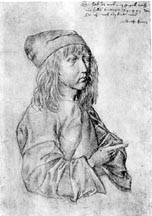
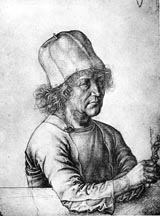
Men are not born, but fashioned- Desiderius Erasmus
Jacob Burckhardt, The Civilization of the Italian Renaissance, 1860. The following is from the introduction to the second part of the book, entitled "The Development of the Individual": In the Middle Ages both sides of human consciousness--that which was turned within as that which was turned without-- lay dreaming or half awake beneath a common veil. The veil was woven of faith, illusion, and childish prepossession, through which the world and history were seen clad in strange hues. Man was conscious of himself only as a member of a race, people, party, family, or corporation--only through some general category. In Italy this veil first melted into air; an objective treatment and consideration of the State and of all the things of this world became possible. The subjective side at the same time asserted itself with corresponding emphasis; man became a spiritual individual, and recognized himself as such. In the same way the Greek had once distinguished himself from the barbarian, and the Arab had felt himself an individual at a time when other Asiatics knew themselves only as members of a race. It will not be difficult to show that this result was due above all to the political circumstances of Italy.
Stephen Greenblatt, Renaissance Self-Fashioning, 1980, p. 256: It seemed to me the very hallmark of the Renaissance that middle-class and aristocratic males began to feel that they possessed such shaping power over their lives, and I saw this power and the freedom it implied as an important element in my own sense of myself. But as my work progressed, I perceived that fashioning oneself and being fashioned by cultural institutions-- family, religion, state-- were inseparably intertwined. In all my texts and documents, there were, so far as I could tell, no moments of pure, unfettered subjectivity; indeed, the human subject itself began to seem remarkably unfree, the ideological product of the relations of power in a particular society. Whenever I focused sharply upon a moment of apparently autonomous self-fashioning, I found not an epiphany of identity freely chosen but a cultural artifact. If there remained traces of free choice, the choice was among possibilities whose range was strictly delineated by the social and ideological system in force. |
In our modern ideology, we take it as natural the sense of ourselves as unique, autonomous individuals. We have a belief in our unique personal identity. Modern Art History has reinforced this ideology with its construction of the narrative of art around the work of identifiable artists whose styles are seen as manifestations of the respective artists' unique personalities. Self-Portraits of artists like Rubens, Rembrandt, and Van Gogh are major monuments in this cult of artistic individuality. Where traditional narratives of Art History have explicitly or implicitly assumed the emphasis on artistic individuality beginning in the Renaissance as the "natural" emergence of the self, recent critical theory has emphasized that the conception of the self is in actuality a construction with a specific social history. We consciously or unconsciously fashion our identities out of the alternatives our cultural contexts provide.
Any discussion of the early modern conception of the artist needs to focus on the remarkable series of self-representations by the German late fifteenth and early fifteenth century artist, Albrecht Dürer. From our experience with later European art, we take for granted the subject matter of the self-portrait. While Dürer was not the first artist to produce a self-portrait, he can be arguably claimed to be the first artist that returned to this subject matter throughout his career. In these images Dürer constructs or, in the terms of Stephen Greenblatt, "fashions" his identity as an artist [for a discussion of the idea of "self-fashioning, see the excerpts from an article by John Martin]. Joseph Koerner, in his book entitled The Moment of Self-Portraiture in German Renaissance Art, has written:
| A glance at the artist's earlier likenesses...complicates our ideas about the unity and function of the self in self-portraiture at 1500. Viewed in succession, these works chronicle not so much one person's physical and artistic maturation as a sequence of roles enacted by the artist for a variety of occasions. In the Louvre panel of 1493 Dürer outfits himself dutifully as lover and as husband; in the Prado portrait he appears as worldly gentilhuomo ; and in the Munich picture he is something more lofty and audacious, a being fashioned in the image of God. If we sense the person 'Dürer' behind this change of costumes, it is only in the gap between, on the one hand, the garb that fixes the sitter into his various roles and, on the other hand, the sitter's face that, remaining constant through the panels, gazes out of the picture with a conviction and an immediacy at odds with the variously clothed body. |
The earliest self-portrait we have of Dürer is a remarkable silverpoint drawing he did in 1484 when he was thirteen years old. This portrait is frequently paired with what is perhaps a self-portrait of Dürer's father, a goldsmith:


The elder Albrecht Dürer, shown holding a piece of his goldsmith work, represents himself as a craftsman. Compare this representation to our discussion of Rogier van der Weyden's painting of St. Luke Drawing the Virgin:
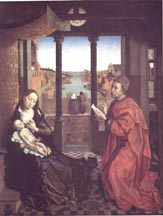
Significantly, Rogier shows St. Luke making a silverpoint drawing. Implicit in this painting is the demonstration of St. Luke's "mastery" of this difficult drawing technique. Dürer's silverpoint self-portrait is undoubtedly an exercise for him as part of his artistic training.
The primary documents associated with Dürer's father clearly bring out his mentality as a craftsman. Read for example the excerpt from the Dürer family chronicle and a letter Albrecht Dürer the Elder sent to his wife. The double portrait of his mother and father that the younger Dürer painted in 1490 should probably be seen in relationship to other double portraits of husbands and wives as managers of household economies engaged in the craft industry:
The idea of the craftsman participating in a household economy is suggested by an engraving by Israhel van Meckenem (c. 1440/5-1503):
Dated about 1490, the print represents the artist with his wife Ida and can be seen as a statement of partnership of the husband and wife managing a successful workshop specializing in the production print copies of the works of other engravers. Of the over 600 signed prints by Israhel, 90% of them can be identified as being based on the work of others. 58 of his prints, for example, copy the work of Martin Schongauer. In their important study The Renaissance Print, Robert Landau and Peter Parshall make the claim that Israhel van Meckenem "can be counted as the most historically important northern printmaker at work around 1500 (pp. 56-57)." This seems to us an odd claim when we consider the apparent lack of originality of Israhel van Meckenem's work, but Landau's and Parshall's point has merit when the wide dissemination of his work is considered. He saw the potential of marketing prints as a commodity.
| Martin Schongauer, Death of the Virgin, c. 1480, engraving. | Israhel van Meckenem, Death of the Virgin, c. 1490-1500, engraving. |
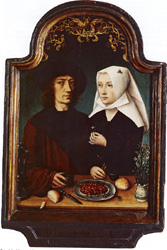 Making
a marketable commodity was thus the priority of Israhel van Meckenem's
shop over originality. A double portrait of the artist and his
wife dated 1496 by an artist known as the Master of Frankfurt again documents
the world of the household economy of the craftsman.
Making
a marketable commodity was thus the priority of Israhel van Meckenem's
shop over originality. A double portrait of the artist and his
wife dated 1496 by an artist known as the Master of Frankfurt again documents
the world of the household economy of the craftsman. 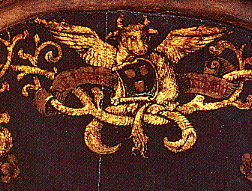 The
arms of St. Luke along with the motto Wt Jonsten versamt ('gathered from joy') above in the fictive frame document membership in the
Antwerp Guild of St. Luke. The flowers held by lady and in the vase also refer to the guild. In 1480 the Antwerp painters' guild had merged with Chamber of Rhetoric known as 'De Violieren" ('The Stock-Gillyflowers'). The lady's hand prominently displays her wedding ring while she holds on to what appear to be prayer beads much like what Dürer's parents hold in their double portrait. The details of the still life on the table and their
clothing are signs of their relative prosperity. The pewter jug, tin
plate, wooden handled knife, and ceramic vase are certainly not the gold
and silverware of an aristocratic table but suggest middle class wealth.
Their value resides in the quality of their manufacture rather than the
intrinsic cost of the materials used.
The
arms of St. Luke along with the motto Wt Jonsten versamt ('gathered from joy') above in the fictive frame document membership in the
Antwerp Guild of St. Luke. The flowers held by lady and in the vase also refer to the guild. In 1480 the Antwerp painters' guild had merged with Chamber of Rhetoric known as 'De Violieren" ('The Stock-Gillyflowers'). The lady's hand prominently displays her wedding ring while she holds on to what appear to be prayer beads much like what Dürer's parents hold in their double portrait. The details of the still life on the table and their
clothing are signs of their relative prosperity. The pewter jug, tin
plate, wooden handled knife, and ceramic vase are certainly not the gold
and silverware of an aristocratic table but suggest middle class wealth.
Their value resides in the quality of their manufacture rather than the
intrinsic cost of the materials used.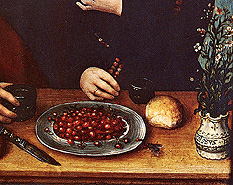 The
painter's mastery of illusionistic painting is attested to by the flies
painted as if they had landed on the surface of the painting. Like the
birds that were fooled by Zeuxis's painting of grapes, the flies appear
to be fooled by the illusionistic representation. The painting attests
to the quality of the master's work and the success of his well managed
workshop. This painting perhaps served as a demonstration of the
shops wares placed in the window of the shop.
The
painter's mastery of illusionistic painting is attested to by the flies
painted as if they had landed on the surface of the painting. Like the
birds that were fooled by Zeuxis's painting of grapes, the flies appear
to be fooled by the illusionistic representation. The painting attests
to the quality of the master's work and the success of his well managed
workshop. This painting perhaps served as a demonstration of the
shops wares placed in the window of the shop. 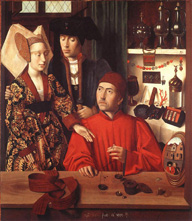 The reference to a workshop window with a ledge like that shown in the painting of the goldsmith by Petrus Christus was enhanced by the original format of having the painting protected by shutters.
The reference to a workshop window with a ledge like that shown in the painting of the goldsmith by Petrus Christus was enhanced by the original format of having the painting protected by shutters.
The partnership of the husband and wife managing a successful workshop suggested by both the Israhel von Meckenem print and the Master of Frankfurt painting is echoed in a letter from Albrecht Dürer's father to his wife Barbara:
| My friendly greeting to my dear Barbara. This is to let you know that, after a hard trip, I arrived in Linz on Sunday before St. Bartholomew's [August 19], and on Monday my gracious Lord [Kaiser Friedrich III] sent for me and I had to show him the pictures [presumably drawings for gold work under consideration]. His Grace was pleased with them and His Grace spoke with me for a long time. And as I was leaving, His Grace came himself to me put four florins in my hand and said to me "My goldsmith, go to the inn and get yourself something good." Since then I have not been with His Grace again.... I have no more [news]: so greet the household for me, and tell the apprentices to work fast and I will earn more; and especially recommend me to my children and tell them to be good. Given at Linz on St. Bartholomew's Day 1492. |
This close partnership provides a striking contrast to the apparently distant relationship between Dürer himself and his wife Agnes. When they got married, Agnes had the expectation of being the wife of a master and helping him in the management of a workshop [see excerpt of Pirckheimer letter written in 1530]. It is significant that there is no double portrait of Dürer and his wife Agnes comparable to the Israhel von Meckenem print, the painting by the Master of Frankfurt, or Dürer's own portrait of his parents. In fact there are relatively few portraits of Agnes in all the work of Dürer.
Contrast these representations with the self-portrait that Dürer painted in 1498 that is now in the Prado collection:
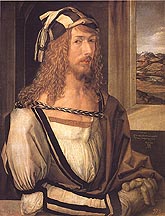
This painting was done after Dürer's first trip to Italy in 1494-95 and the year before the publication of his famous edition of the Apocalypse. In 1498, Dürer had been elevated to a status rivaling that of a member of the upper social circles of the city, the Ehrbaren, or wealth merchant. Compare this portrait to the attitudes he expresses in a series of letters he writes to his friend Willibald Pirckheimer during his second trip to Italy. Note especially the following statement of regret about returning back home to Germany after his stay in Italy: "How I shall freeze after this sun! Here I am a gentleman, at home only a parasite." Read Joseph Koerner's discussion of this self-portrait.
In 1500, Dürer painted his famous self-portrait now in Münich:
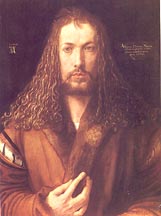
Inscription: "Albertus Durerus Noricus ipsum me propriis sic effingebam coloribus aetatis anno xxviii" (I, Albrecht Dürer of Nuremberg painted myself thus, with undying colors, at the age of twenty-eight years)
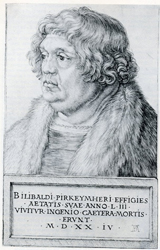 While Dürer in the 1500 portrait does not wear the fashionable dress of the 1498 portrait, his clothing with the fur collar can be compared to that represented in the 1524 engraving of his friend and Nuremberg patrician, Wilibald Pirckheimer. The contrast in dress between the two self-portraits could be perhaps compared to the contemporary contrast between Gucci and Brooks Brothers, with one showing contemporary fashion and the other a traditional sign of high status.
While Dürer in the 1500 portrait does not wear the fashionable dress of the 1498 portrait, his clothing with the fur collar can be compared to that represented in the 1524 engraving of his friend and Nuremberg patrician, Wilibald Pirckheimer. The contrast in dress between the two self-portraits could be perhaps compared to the contemporary contrast between Gucci and Brooks Brothers, with one showing contemporary fashion and the other a traditional sign of high status.
It has long been known that this self-portrait is based on a convention for representing Christ that can be found in Netherlandish art like this image of the Holy Face associated with the work of Jan Van Eyck:
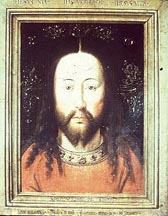
Van Eyck's image can be linked to a tradition of Pantocrator images found in Byzantine churches like the following one on the left from the church of Daphni built about 1100 just outside of Athens and two from Sicily (Monreale and Céfalu) from the end of the 12th century:
|
Pantocrator from Céfalu in Sicily. (text in Christ's book is John, 8, 12) |
Notice how the Byzantine images and the Dürer Self-Portrait share details like the lock of hair extending down the center of the forehead and the prominent position of the right hand. This image of Christ as Pantocrator, or ruler and judge of the world, is a descendent of the so-called acheiropoetai, the "images not made by human hands." Read Koerner's account of this painting.
In 1522, Dürer created a dramatically different self-representation in a lead point drawing of himself in the guise of Christ as the "Man of Sorrows":
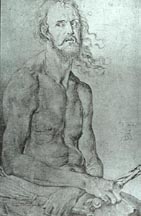
Compare this drawing to Dürer's painting of the Man of Sorrows from 1493-94:
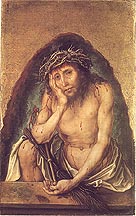
While strictly not self-portraits, I would like to consider two other images as self-representations. One is a drawing of an artist drawing a nude that was used as an illustration of a perspective device in Dürer's Painter's Manual of 1525:
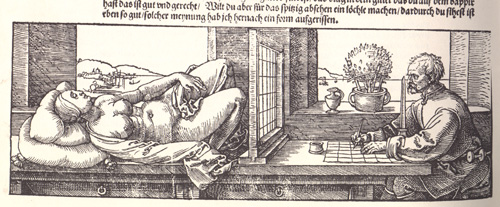
This image has been the focus of much discussion in contemporary theory. Read the excerpts included on the page dedicated to this image.
The other image is the famous engraving dated to 1514 entitled Melancolia I:
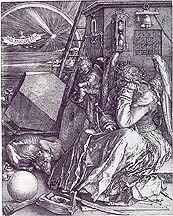
The principal figure can be identified as the female personification of melancholy. This temperament became associated during this period with the creative artist. This can thus be seen as a spiritual self-portrait of Dürer. "Number,weight, and measure."
Self-Portraits of Albrecht Dürer |
|